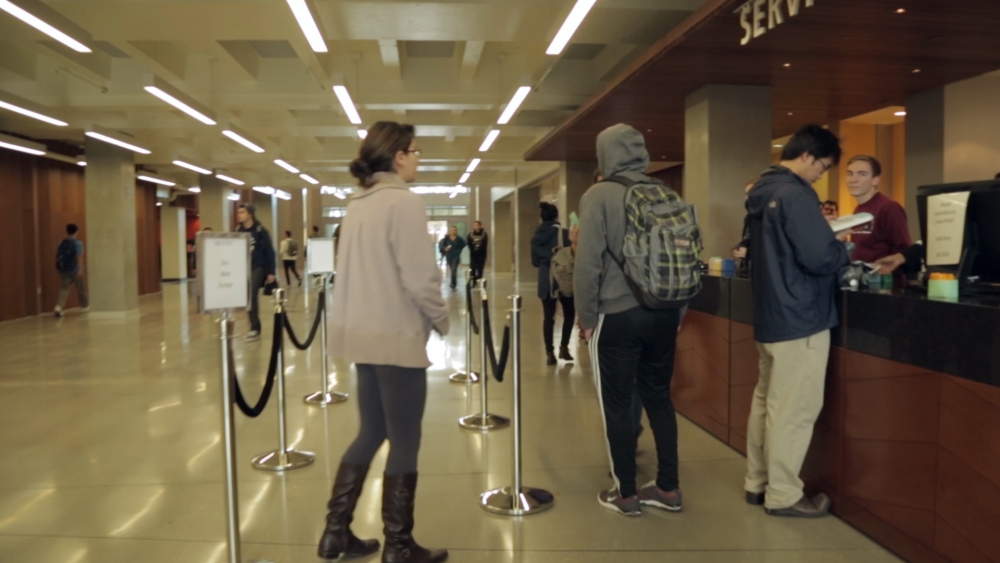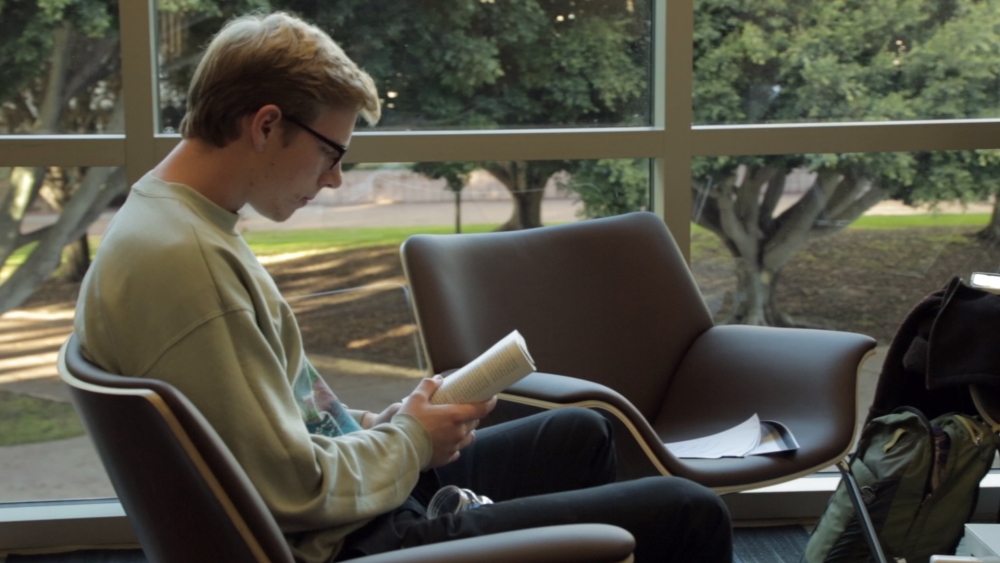‘The Heart of Campus’



More than two years after construction began — and a full decade since the project was first proposed — a modernized library at UC Santa Barbara is open for business.
Reimagined as a cutting-edge facility for collaborative, interdisciplinary research and education, the reborn UCSB Library is a far cry from the dark, solitary spaces often associated with library study. The new structure is bright and airy, with a soaring entryway (formally called the Paseo) and abundant natural light.
A State-of-the-Art Resource
“This new state-of-the-art facility enriches the resources available to our students, faculty and staff, and integrates our physical and virtual learning spaces,” said UCSB Chancellor Henry T. Yang.
Because it is part of UC Libraries and allows access to a wide scope of materials beyond those available in the physical library, the UCSB Library is a rich resource for the campus and Santa Barbara community. In fact, the UC Library as a whole is the second largest research library in the world (second only to the Library of Congress).
“The new library is much more reflective of the kind of work faculty and students are doing in 2016,” said UCSB University Librarian Denise Stephens, who has been shepherding the ambitious re-imagining of the space. “There is a great deal more capacity to engage users directly, to work with research projects and to promote collaborative study.”
Uniting the Campus Both Literally and Figuratively
Encompassing a brand-new 60,000-square-foot addition and a 92,000-square-foot renovated structure designed by Pfeiffer Partners Architects, the UCSB Library now serves to unite the east and west sides of campus both physically and symbolically.
Stephens said she believes the location of the library makes it an anchor for the entire university, connecting disparate fields of study in a single space that can serve all of the needs of the modern scholar. “It’s at the heart of campus,” she said. “It really does represent the crossroads of UCSB.”
In addition to functioning as a centrally located meeting spot and important campus landmark, the new library will expand the academic experience at UCSB. “This space will improve productivity,” Stephens noted. “At the end of the day, what we are here to do is make sure people have access to the information and tools that are necessary for them to be productive in their scholarship.”
Yang echoed her sentiments. “At the heart of every great research university is its library,” he said. “Our library at UC Santa Barbara provides the lifeblood for every part of our vibrant university and serves as a vital resource not just for our campus and community, but for scholars around the globe. As a hub of information and intellectual engagement, it is a key component in fulfilling our university’s mission — enhancing interdisciplinary collaboration, inspiring discovery and innovation across disciplines, and stimulating independent thought, critical reasoning and creativity.”
State-of-the-Art Scholarship
The project was designed with the contemporary college student in mind. A group of undergraduates participated in roundtable discussions about their needs before the library design was finalized, and later helped with furniture selection for the space. Their primary request, second only to more power outlets for computers and other portable devices, was comfortable, sunlit areas in which to study, both alone and in groups, at any time of day or night.
To meet these needs, the library has made key changes that engage the digital, wireless culture of the 21st century. “The modern library is about opening access and removing boundaries and barriers so that our students and researchers can easily get to information,” Stephens explained. “We use technology aggressively, creatively and proactively, to ensure that we are not only able to help people discover what exists out there, but to make sure that wherever it is and whatever format it is in, they can get to it.”
Discussions about a new library date back approximately two decades and focused on increasing book storage. But in planning construction for a 2013 groundbreaking, library officials shifted course. They realized that a new structure was necessary not only to house the more than 3 million volumes currently in the library’s collection, but also to accommodate people.
To that end, the new library has 20 percent more study space designed and configured to suit the diverse study habits of the student population. In addition to secluded desks and computer stations, special graduate student study spaces, and a 24-hour Learning Commons dedicated to student success, the library has increased the number of PC and Mac computers available around the clock. Equally important, a brand new café has been included to provide sustenance to hard working students.
“What we see in the design of the newer spaces is a reflection of the fact that there’s a duality in study habits,” Stephens said. “Students need to work as individual scholars, but they also need to work in partnerships.” The library now boasts more than a dozen new group study rooms that seat anywhere from four to 16 people. Students can reserve them online as needed.
Designed With Collaboration in Mind
The UCSB Library also serves the needs of faculty undertaking complex and often groundbreaking research. Stephens called it “the campus’s largest living laboratory,” and pointed out that much of the scholarly work being done at UCSB is often informed by interactions with the library.
The new structure has a dedicated area designed to facilitate data creation, curation and analysis among faculty members across departments and divisions. This unique space, called the Interdisciplinary Learning Collaboratory, offers computers, meeting space and expert data consultation for UCSB researchers.
All Under One Roof
The new structure contains some book storage in the form of state-of-the-art, temperature-controlled preservation space for UCSB’s Special Research Collections, consisting of rare and unique books.
These collections include Bibles from the 13th century, first and early editions of works by Charles Dickens and Edgar Allan Poe, and more than 3,400 volumes of work relating to the debate on evolution. Among other audio and digital recordings, the special research collections department also houses the UCSB Cylinder Audio Archive, which provides free access to a digital collection of nearly 16,000 cylinder recordings.
The addition of square footage allows for a consolidation of other libraries that were previously located elsewhere on campus. The Arts Collection, which contains books on architecture, fine arts and photography and previously was situated in the Music building, is now under the same roof as the rest of the UCSB Library collection. And with its expanded hours of operation, the Arts Collection gives students greater access to reading galleries and study carrels.
Going Green
In keeping with UCSB’s commitment to sustainability, the new structure features energy-efficient lighting, drought-tolerant landscaping and building materials made of recycled content. It is anticipated that the building will be certified LEED Gold by the U.S. Green Building Council.
“UCSB is tremendously proud to be at the forefront of sustainability efforts in all of our new construction projects,” said Marc Fisher, vice chancellor for administrative services. “We see ourselves as leaders in this area, and are committed to using renewable resources and green building practices not just for this project, but whenever possible. The library renovation and addition posed a special challenge given the complexity of integrating old and new building systems, but we are pleased with the outcome and anticipate a strong LEED rating.”
For the 21st Century and Beyond
The new and renovated spaces provide UCSB with the modern university library it requires to support scholarly research and collaboration across disciplines. Stephens said she thinks of the UCSB library as a fluid, adaptive organization. Over the next year, she and her 150 library staff members will pay careful attention to how well the new space performs and make adjustments accordingly.
“Ultimately the modern university library is a learning organization,” Stephens said, reflecting on the importance of the institution remaining flexible and open to change. “We intend to examine what is happening in the world around us, to learn from it and to evolve.”
Those interested in visiting the new space can take advantage of drop-in tours led by library staff. These will take place every Tuesday and Wednesday at noon throughout the month of January. No prior reservation is required for the 45-minute tour, which begins on the first floor of the Paseo.
The UCSB Library also will host a grand opening celebration Wednesday, Jan. 13, from 3:30 to 5:30 p.m. Festivities will include a ribbon-cutting ceremony, performances by UCSB students from the departments of music and of theater and dance, and an open house. The event is free and open to the public. For more information and to RSVP, visit the library’s website at http://www.library.ucsb.edu.



